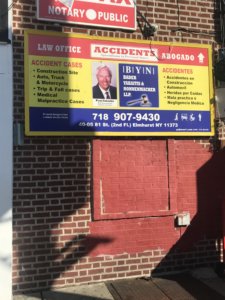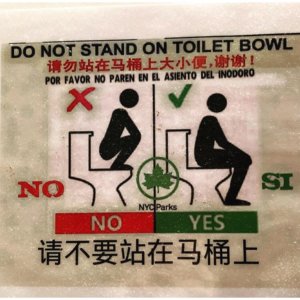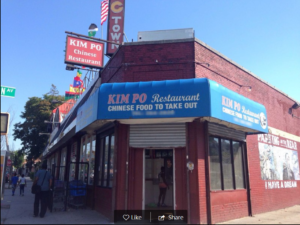https://docs.google.com/document/d/1tfgLnNkKL_efFEVuiX7ZO2s510wvFeJcLAWqzsfhq7k/edit
]]>
Read More]]>
Even though this is a bilingual sign , the dominant language of this linguistic landscape is Spanish , because the targeted audience is Spanish speakers. They use black for both languages, but sometimes you would see in certain linguistic landscapes a language in a more vibrant color. Usually they would used a more outstanding color to show the dominant language, depending on the area where the sign is.
What I found interesting was that around Roosevelt there would be more linguistic landscapes with colors like red , yellow and blue, which they probably do that so the audience feels a certain connection or just to grab the attentions since they are bright colors.
Questions
was there any part of my essay where I may have confused the reader?
is there something else that I should add to my essay?

Read More]]>
This linguistic landscape is not only telling us that the owner of this vehicle is Puerto Rican, but that they are proud of it. The symbol is emphatic, with the use of an exclamation mark at the end of the quote. The history of this quote specifically is that in 1995, Taino (Joel Bosch) released a song with the title of this quote. Following this, the quote became a symbol for Puerto Ricans around the world, and nearly an icon. In New York City, at the Puerto Rican Day Parade, this quote is still chanted by many. This sign gives me a clue that this neighborhood may have a population of Puerto Rican people. I know this for a fact, as I went to a high school two blocks from this sign, and have a lot of Puerto Rican friends who live in the area. This sign is written in Spanish, yet it’s ‘slang’. This is because it does not follow the proper grammar of written Spanish. This is most likely due to the fact that the symbol is meant to reinforce Puerto Rican pride, and grab the attention of the reader. The improper grammar is also a means of being unique and displaying part of the Puerto Rican culture (through its language).

- Do you think I should go beyond the sign in this neighborhood, and go more in-depth on what my Puerto Rican friends who live there have told me?
- How could I add to my first, description paragraph?
Read More]]>
Linguistic landscapes can be found all around us. You may not notice them as often due to the fact that they may be things that you see every single day, especially when live in a location like New York City. Here is a linguistic landscape I discovered during a trip to the manhattan side pier with my niece and other family members.

This linguistic landscape was pointed out to me by my 10 year-old niece while we were in the public restroom for an emergency. This all took place in Seaport, Pier 17, New York, NY. This sign is multilingual meaning it contains several different languages to help distribute an important message to the public.
Every sign that is posted up can have many different meanings and interpretations. In this case, this sign’s purpose it to teach people of this neighborhood how to properly sit on the toilet. I can infer that maybe there have been many unsanitary incidents, where it was noticeable to the employees of theNYC parks, that people were not properly using these toilets. The message of this linguistic landscape states that people should sit on the seats accordingly, and the meta message is that, most people may not have as much common sense as others but for people to please use the restrooms as if they were in their homes, with respect.
By the look of it, this linguistic landscape tells us that the neighborhood around it is pretty diverse. The sign includes the three major languages in the US. We can conclude that people who speak English, Spanish and Chinese live/visit this neighborhood often. This could possibly mean that this neighborhood has a mix of different people in different social classes.
This linguistic landscape is showing that the community of the city of New York can be very complex. It is one of the most crowded places in the US therefore we always find ourselves in awkward, sticky situations like having an emergency and needing to use the bathroom but not being able to because you notice there are footprints on the toilet seat…
Questions
- Is there another way I can relate this linguistic landscape to the community?
- I think I can elaborate more on the meaning behind this linguistic landscape. Agree/Disagree?
Read More]]>
The index of the sign initially tells me that the message is more expressed and enthused with the English due to the style of how it was presented, as for the other languages where smaller and somewhat unrecognizable if you don’t pay close attention. Then I thought about the linguistic landscape and realized that the neighborhood tends to be mainly White and Spanish, which makes sense why the first two languages on the sign were English and then Spanish. Sometimes I have to call on a co-worker to help and translate English to Spanish for proper customer service. One other thing that the sign does show me is that even though the other three languages aside from English are less noticeable, that the store acknowledges that we attract more then just what the neighborhood holds in its population.
in conclusion to this analysis, there is a lot of diverse people that come to the store. our location is still new so maybe in soon enough time the signs will start to evolve into more languages.

Read More]]>
ELL 100
10-24-18

Linguistic Landscape
Language is displayed all around us in all types of way. Some of the most known ways would be through signs such as shop windows, commercials, posters, official notes, and traffic signs. There are also other forms of signs but people tend to not pay attention to the linguistic landscapes around them. One of the ways linguistic landscape could be used is for the general description and analysis of a certain situation. It can be in many different languages in geographical areas. In some cases, sings would have two different languages but have the same meaning. Linguistic landscape is not only through signs, but in speech and writing as well. Language does not only assume it’s in the present, but also brings the language from the history and the past of the language.
I used a sign that is in the train station that gives directions to which train are available. The sign only includes one language which is called monolingual. The sign is looked to be as authorized because it gives directions for transportation. The sign seems to be organized because it is strictly giving information about what is available in the train station and where the train’s destinations are. This sign is found at 59th street in Manhattan. The sign is Top-down because it contains official information and is shown to be given public announcements to the people who want to use the train station for transportation.
The sign can be used by different kind of people. It can be used for people whose first time taking the train and not sure which where to go so they can use the sign for directions. Others would see the sign but wouldn’t really pay attention to it because they already know the ways of transportation in that area. Even though a person knows that they are in the right train station, they would still have to read it to make sure that they are in the right place. For me, I would know what train station I am in but I would make sure to read the sign before entering to make sure the train I need for transportation is available.
q1- what information can i add to my body paragraph?
q2- should i explain the sign more?
]]>Read More]]>
The landscape, judging from the lottery logo and delicacies, is an open invitation to others to not only take part in those activities, but that those activities are available within the establishment as well. And, perhaps, to get more customers by assuming their interests. This can also be directed to the stratification and demographics of the borderline low to middle class as the lottery and image of money can be used to entice customers for more, while the delicacies urge that they can also afford to spend more as well. Because the landscape is complementary, it informs that the majority of the community and neighborhood is bilingual mostly capable of speaking both Spanish and English. The landscape also seems to be tailored towards adults as there is no present advertising of childhood attractions such as toys, games, candy, and…balloons.
Even though the linguistic landscape is a combination of both Spanish and English, the community itself offers a bit more than that. Within the neighborhood there are also Asians, Arabs, and other races that reside in the area alongside Spanish and English speakers that speak and communicate in other languages. Although, with the exception of Chinese restaurants, there are not many other stores or locations that have a hybrid of English with Asian, Arab and other languages. In addition, the amount of Spanish and English landscape stores are actually scarce throughout the neighborhood. However, the chances of the personnel inside being able to communicate in those languages are and can be pretty high.

Q1: Does this essay seem fluid and connected? If not, how can I arrange it as so?
Q2: Is there anything that you feel lacks clarity or needs more emphasis/input?
]]>Read More]]>
The linguistic landscape I chose was of the entrance of a church. This church is located in Astoria, Queens on Crescent Street. There are many bilingual signs that surround the doors of the church. There are two banners that take up the glass panels on the doors in big white writing saying “Good Shepherd” “United Methodist Church” and on the bottom, the name of the Reverend, the times and the phone number. On the left side of the panel, all of the writing is in Korean. On the right side of the panel, it is translated all into English. On the top of the double doors are two huge signs. One sign states again “Good Shepherd” in bold white font with the Korean on top and the English on the bottom. The other sign is in a framed white background with the words “Heaven & Hell Are Real! Be Prepared” in red and the Korean translation beneath it in blue. On the side of the doors there is a little sign in blue indicating where the church parking is, in both English and Korean.
This linguistic landscape is showing the presence of a religious community. This church shows that there are people in the community that share the same religious background within the same general location. Not only does the church inform us about the community but the languages displayed outside on the signs also inform us. The signs show us that there is a large enough group of Korean speakers in the community for them to have a place of worship in the comfort of their own language. It also shows us that the Korean speaking and the English speaking communities come together in this place to express their religious practices.
In this area of the neighborhood there are mostly tall apartment building around it. Across the street there is another church. There is also a hospital diagonally across from the “Good Shepherd” church. The neighborhood is not predominantly Korean so I found it interesting to learn that the language was Korean.

Questions:
1) Did i provide a good visual?
2) What can I expand on further?
]]>Read More]]>

In my prominently English neighborhood there’s a single Chinese food restaurant called “Kim Po”. The store is located at Farmers Boulevard in Saint Albans Queens, not too far from where I live. My reason for choosing this sign (besides the fact that it happens to be one of the only signs near my house that’s in a different language) is simple, it’s a store I frequent as well as the very first thing I see when I cross the street to go to the supermarket located right next to it.
While banner is mostly in English, the actual name is in Chinese (though the words uses the Latin alphabet rather than Chinese characters). The banner itself is a bright eye catching blue with all of the English text being in white. However, the restaurant name is in a red color that clashes directly with the blue, drawing the eye to it. I believe this is a way for anyone passing by to be able to easily tell what the store is called, thus remembering it and possibly returning in the future. The reason why the sign is mostly in English is most likely because of what I stated previously, the neighborhood is prominently English so it only makes sense that the sign should be mostly in the language that’s spoken the most in the neighborhood.
The sign, much like the building, is rather simple and homely. However, this is not inherently a bad thing. Farmers Boulevard is is a simple, quiet neighborhood. People going about their business prefer to get what they seek and return to their day. They aren’t interested in anything flashy or over the top. This is reflected in the surrounding neighborhood. To the right of the store (as well as a local C-Town supermarket it shared a building with) is a lengthy row of houses going on and on for many blocks. There is also an elementary school directly in front of it (it’s a block away but still in front nonetheless). Students like to visit for a quick after school meal and families like to visit for an out of house meal.
To conclude, this store has been a part of this neighborhood for quite some time. Though the name of the restaurant and the people inside are both Chinese, people are still able to communicate and get what it is they want.
Questions
#1 Did I follow the rubric well or did I go off topic?
#2 What can I do to make this essay better, especially regarding my conclusion.
]]>Read More]]>
My sign or linguistic landscape is on 67th avenue on Queens Blvd, this is from a neighborhood where you can find a lot of Russians or Chinese people mostly. As you can see by the font it is the same for both languages, the languages here are English and Chinese. I don’t see any difference between color in the languages and as you can tell there is a mix of different cultures, the sign to the right says knish which is something that is known to be eaten by jewish people. This landscape can tell us that there are Chinese people around the neighborhood and American people that might like that type of food that they make. I can tell by that because its not only in Chinese language it’s also in English which shows that they want more than their people to come in, they want people to come in and get what they are selling. I would say that there’s no really meaning to the sign that can show who they are mainly focus on because both of the languages are big and good enough to see from far away. There’s a mix of all people but I think that the main ones are Chinese, Russian and American people that live in my neighborhood, as I walk around you can find many different stores that can show you what the neighborhood is filled with. Mostly Russian restaurants and stores are filled up over here but you can still find other places that are from different cultures.
The neighborhood is more than just signs because there’s places that are for everyone its not focusing on that one ethnicity such as the big brand name resturants and clothing stores. I feel that my neighborhood is full of many cultures but based on what I see its mainly Chinese and Russian people, they have many stores around where I live. Another factor can be the cars that I hear in my neighborhood, all the Russian people seem to have all the new cars and you know they are new is when you can hear them roaring in the background when you’re walking.
Linguistics Landscapes are all around you when you go on the train or even when you walk around. The signs can show you many factors in the neighborhood, as seen in my landscape it shows that many Chinese and Russian people live in my area.

Q1: Is my essay clear and a good understanding of the neighborhood?
Q2: How can I expand more?
]]>